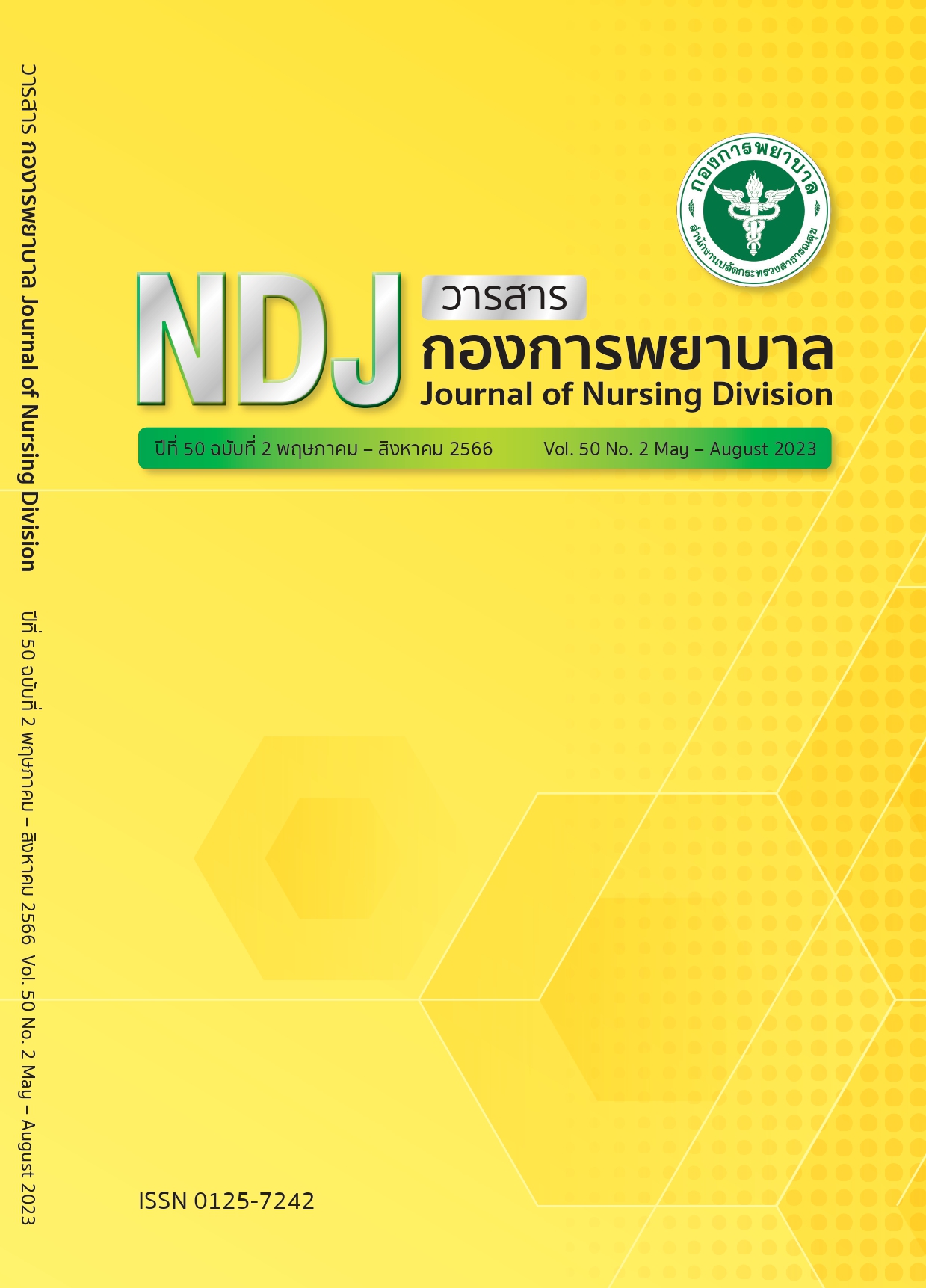ปัจจัยที่มีความสัมพันธ์ต่ออาการทางคลินิกทรุดลงในผู้ป่วยภาวะพิษเหตุติดเชื้อหลังเข้ารับการรักษาในโรงพยาบาลภายใน 72 ชั่วโมง
Main Article Content
บทคัดย่อ
บทคัดย่อ
การวิจัยนี้เป็นการศึกษาจากเหตุไปหาผลแบบย้อนหลัง มีวัตถุประสงค์เพื่อศึกษาอุบัติการณ์และปัจจัยที่มีความสัมพันธ์ต่ออาการทางคลินิกทรุดลงในผู้ป่วยภาวะพิษเหตุติดเชื้อหลังเข้ารับการรักษาในโรงพยาบาลภายใน 72 ชั่วโมง กลุ่มตัวอย่างเป็นผู้ป่วยที่ได้รับการวินิจฉัยภาวะพิษเหตุติดเชื้อที่แผนกอุบัติเหตุและฉุกเฉินและแผนกผู้ป่วยใน โรงพยาบาลลำปาง 270 คน เก็บรวบรวมข้อมูลจากเวชระเบียน ระหว่างเดือนกันยายน 2563 ถึง สิงหาคม 2564 เครื่องมือที่ใช้ในการวิจัย ได้แก่ แบบบันทึกข้อมูลส่วนบุคคลของผู้ป่วย แบบบันทึกการประเมินภาวะสุขภาพและการดูแลของผู้ป่วย และแบบประเมินอาการทางคลินิกทรุดลง ได้รับการตรวจสอบความตรงเชิงเนื้อหาจากผู้ทรงคุณวุฒิ 3 คน มีดัชนีความตรงเชิงเนื้อหาเท่ากับ .96 วิเคราะห์ข้อมูลด้วยสถิติเชิงพรรณนาและสถิติถดถอยโลจิสติกแบบทวิ
ผลการวิจัยพบว่า ผู้ป่วยภาวะพิษเหตุติดเชื้อเกิดอาการทางคลินิกทรุดลงหลังเข้ารับการรักษาระหว่าง 6-72 ชั่วโมง ร้อยละ 53.70 อาการทางคลินิกทรุดลง ได้แก่ ระบบไหลเวียนโลหิต ระบบหายใจ และระบบประสาทและสมอง ตามลำดับ ปัจจัยที่มีความสัมพันธ์ต่ออาการทางคลินิกทรุดลงได้อย่างมีนัยสำคัญมากที่สุด ได้แก่ ผู้ป่วยที่เข้ารับการรักษาในหอผู้ป่วยหนัก เกิดอาการทรุดลง 2.69 เท่า (95% CI 1.16-5.05) รองลงมา คือ โรคประจำตัว และอายุตามลำดับ โดยพบว่าผู้ที่มีโรคประจำตัว 1 โรค เกิดอาการทรุดลง 2.42 เท่า (95% CI 1.16-5.05) และโรคประจำตัวมากกว่า 1 โรค เกิดอาการทรุดลง 2.75 เท่า (95% CI 1.30-5.80) ผู้ที่มีอายุระหว่าง 70-79
Article Details

อนุญาตภายใต้เงื่อนไข Creative Commons Attribution-NonCommercial-NoDerivatives 4.0 International License.
เอกสารอ้างอิง
Reference
Rudd KE, Johnson SC, Agesa KM, Shackelford KA, Tsoi D, Kievlan DR, et al. Global, regional, and national sepsis incidence and mortality, 1990–2017: analysis for the Global Burden of Disease Study. The Lancet. 2020;395(10219):200-11.
Capp R, Horton CL, Takhar SS, Ginde AA, Peak DA, Zane R, et al. Predictors of patients who present to the emergency department with sepsis and progress to septic shock between 4 and 48 hours of emergency department arrival. Critical care medicine. 2015;43(5):983-8.
Indicator 34: Mortality rate of community-acquired sepsis patients [Internet]. 2020 [cited January 2021 ]. Available from: http://healthkpi.moph.go.th/kpi2/kpi/index/?id=1448. Thai.
Fleischmann C, Thomas-Rueddel DO, Hartmann M, Hartog CS, Welte T, Heublein S, et al. Hospital Incidence and Mortality Rates of Sepsis. Dtsch Arztebl Int. 2016;113(10):159-66.
Sakr Y, Jaschinski U, Wittebole X, Szakmany T, Lipman J, Ñamendys-Silva SA, et al. Sepsis in Intensive Care Unit Patients: Worldwide Data From the Intensive Care over Nations Audit. Open Forum Infect Dis. 2018;5(12):ofy313.
Quinten VM, van Meurs M, Wolffensperger AE, Ter Maaten JC, Ligtenberg JJ. Sepsis patients in the emergency department: stratification using the Clinical Impression Score, Predisposition, Infection, Response and Organ dysfunction score or quick Sequential Organ Failure Assessment score? European Journal of Emergency Medicine. 2018;25(5):328.
Quinten VM, van Meurs M, Wolffensperger AE, Ter Maaten JC, Ligtenberg JJM. Sepsis patients in the emergency department: stratification using the Clinical Impression Score, Predisposition, Infection, Response and Organ dysfunction score or quick Sequential Organ Failure Assessment score? Eur J Emerg Med. 2018;25(5):328-34.
Dugar S, Choudhary C, Duggal A. Sepsis and septic shock: Guideline-based management. Cleve Clin J Med. 2020;87(1):53-64.
Bunyaphatkun P, Sindhu S, Davidson PM, Utriyaprasit K, Viwatwongkasem C, Chartbunchachai W. Factors influencing clinical deterioration in persons with sepsis. Pacific Rim International Journal of Nursing Research. 2017;21(2):135-47. Thai.
Angkasekwinai N, Rattanaumpawan P, Thamlikitkul V. Epidemiology of sepsis in Siriraj Hospital 2007. J Med Assoc Thai. 2009;92(Suppl 2):S68-78. Thai.
Glickman SW, Cairns CB, Otero RM, Woods CW, Tsalik EL, Langley RJ, et al. Disease progression in hemodynamically stable patients presenting to the emergency department with sepsis. Acad Emerg Med. 2010;17(4):383-90.
Vardi M, Ghanem-Zoubi N, Bitterman H, Abo-Helo N, Yurin V, Weber G, et al. Sepsis in nonagenarians admitted to internal medicine departments: a comparative study of outcomes. QJM: An International Journal of Medicine. 2013;106(3):261-6.
Hall MJ, Williams SN, DeFrances CJ, Golosinskiy A. Inpatient care for septicemia or sepsis: a challenge for patients and hospitals. NCHS Data Brief. 2011(62):1-8.
RCoP L. National Early Warning Score (NEWS): standardising the assessment of acute-illness severity in the NHS. Report of working party London: Royal College of Physicians. 2012.
Martin-Loeches I, Guia MC, Vallecoccia MS, Suarez D, Ibarz M, Irazabal M, et al. Risk factors for mortality in elderly and very elderly critically ill patients with sepsis: a prospective, observational, multicenter cohort study. Annals of intensive care. 2019;9(1):1-9.
Michels EH, Butler JM, Reijnders TD, Cremer OL, Scicluna BP, Uhel F, et al. Association between age and the host response in critically ill patients with sepsis. Critical Care. 2022;26(1):1-16.
Sun GD, Zhang Y, Mo SS, Zhao MY. Multiple Organ Dysfunction Syndrome Caused by Sepsis: Risk Factor Analysis. Int J Gen Med. 2021;14:7159-64.
Wang HE, Weaver MD, Shapiro NI, Yealy DM. Opportunities for Emergency Medical Services care of sepsis. Resuscitation. 2010;81(2):193-7.
Flaatten H, Reinikainen M. Severity scoring, outcome prediction and mortality endpoints in intensive care. Acta Anaesthesiologica Scandinavica. 2015;7(59):819-21.
Yurkova I, Wolf L. Under-triage as a significant factor affecting transfer time between the emergency department and the intensive care unit. J Emerg Nurs. 2011;37(5):491-6.
Andersen RM. Revisiting the behavioral model and access to medical care: does it matter? Journal of health and social behavior. 1995:1-10.
Krejcie RV, Morgan DW. Determining sample size for research activities. Educational and psychological measurement. 1970;30(3):607-10.
McHugh ML. Interrater reliability: the kappa statistic. Biochem Med (Zagreb). 2012;22(3):276-82.
Wang HE, Jones AR, Donnelly JP. Revised National Estimates of Emergency Department Visits for Sepsis in the United States. Crit Care Med. 2017;45(9):1443-9.
Baykara N, Akalın H, Arslanta MK, Hancı V, Çalayan Ç, Kahveci F, et al. Epidemiology of sepsis in intensive care units in Turkey: a multicenter, point-prevalence study. Critical Care. 2018;22(1):93.


